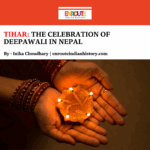
By Riya Pradhan
From the earliest hand-molded Mehrgarh bowls to the highly ornate Iron Age urns, terracotta pottery provides one of the longest and most valuable windows into the prehistoric history of South Asia. Resilient and prolific, ceramics make up what has well been referred to as "the alphabet of archaeology," giving us important chronological markers and testifying to the changes in technology, trade, and social structure.
They are not just simplistic utilitarian containers, but the vessels were transformed into works of art and symbolic meaning. The Indus Valley civilization, for instance, produced rich figurines such as the mother goddesses seated, wheeled ram‑headed toys, and animal amulets that attest to sophisticated beliefs and mundane routines in
one of the world's earliest urban societies.
By the Neolithic age, plain earthenware vessels had started to occur in burial contexts, suggesting a higher concern with the afterlife. In the Chalcolithic age, Red and Grey Ware urns contained skeletal remains, perhaps symbolizing the vessel as a protective "womb" for the soul. This was done with increased sophistication in the Late
Harappan Cemetery H period (c. 1900–1300 BCE), where cremated remains were placed inside painted urns with peacock and hound motifs.
In South India's Iron Age megalithic landscapes of Tamil Nadu, Kerala and Andhra Pradesh, large terracotta urns were typical mortuary containers. Commonly occurring in urn‑cist burials in association with bowls, bead’s and small figurines, these vessels carried individual identity and communal beliefs, being miniature monuments to the
dead. Their exceptional preservation over a millennia so that every sherd and vessel continues to speak, means that we can reconstruct the spiritual, artistic and technological worlds of India's ancient people.
The first evidence of terracotta-urn burial in South Asia is at Mehrgarh (c. 4000–3300 BCE), where children's skeletons were buried in large ceramic jars frequently with ochre and personal ornamentation emphasizing the symbolic agency of the vessel as both container and conduit in mortuary ritual. Such Neolithic jar burials indicate a growing belief in the vessel as a symbolic container of body and soul, and in the growing technical expertise of ceramics.
This article discovers the various urn burial practices across different regions in India highlighting important sites of the same.
Northern Indian
The Northern Indian urn burials are primarily dated to the Late Harappan Cemetery H phase (c. 1900–1300 BCE) at major Indus Valley contexts, such as Rakhigarhi (Haryana), Farmana (Haryana), and Bhagwanpura (Punjab). Excavation at Rakhigarhi produced primary burials and secondary offerings of cremated bones in painted Red
Ware urns that suggest a sophisticated mortuary tradition that express the evolving ideas of the afterlife and social distinction.
Likewise, Farmana produced more than a dozen urn burials with broken bones and copper and gold jewelry in its Early, Mature and Late Harappan periods, reflecting continuity and change in funeral practices.
Outside of the central Harappan area, sites like Sanauli in Uttar Pradesh—dated to the contemporaneous Painted Grey Ware horizon (c. 2000–1200 BCE)—produced terracotta urns closed by lids and decorated with ox figurines, showing a syncretic blend of Indus and post-Urban funerary practices.
Early Iron Age (c. 1000–300 BCE) megalithic urn burials are found at Jharkhand in the Ranchi, Khunti and Chatra districts. Excavations have yielded twelve secondary urn interments under one capstone at Khuntitoli, each holding charred human skeletal remains, copper bangles, agate beads and residues of red ochre indicative of both sophisticated funerary rites and social gradation in society. At Obra, urns appear in conjunction with menhir, some retaining tiny offering pots and iron implements, showing variation in grave goods and ritual offerings.
Similarly in Sillidih and Murvey, the open sites feature urns filled with fragmented cremated remains—practices which indicate the persistent secondary burial practices characteristic of the Munda tribes.
Western India
The Chalcolithic site of Inamgaon, an important Chalcolithic site located on the banks of the Ghod River in Maharashtra, offers critical insights into the burial practices of the Late Jorwe culture (c. 1400–700 BCE).
Urn burials at Inamgaon were often reserved for newborns and young children, demonstrating cultural differences in mortuary practices based on age. The procedure involved placing the remains—usually cremated, but occasionally skeletal—in huge globular or oval pottery jars that were buried in shallow trenches. These jars of burial were composed of fine to medium fabric, sometimes with a red or buff slip, and generally lacked complex decoration, pointing to their functional rather than ornamental purpose.
A lid or a reversed bowl in some instances covered the urn mouth to seal it. At other times, small pots or bowls—most probably offerings—accompanied the jars and were placed beside or even within the urns. Such grave gifts commonly included red ware, or black-on-red ware ceramics, all representative of Jorwe culture. It still preserves twinurn child burials (c. 1800–1500 BCE), with greyred ware jars positioned mouthtomouth beneath house floors, showing both Neolithic jarburial continuity and regional diversification of terracottaurn burial practice. The children were generally buried in two or more pots.
The preference for urn burial among infants and young children perhaps represented their unfinished entry into the social world. The use of ceramic jars—domestic, everyday vessels—as burial containers might indicate a figurative return to the womb or a protective cocoon for the deceased. Furthermore, the scarce grave goods and less complex burial architecture in compared to adult graves indicate age-specific funeral norms in the Jorwe civilization.
Southern India
Adichanallur, situated on the southern bank of the Thamirabarani River in Tamil Nadu's Thoothukudi district, is a major Iron Age cemetery that provides deep insights into the funerary practices and socio-cultural dynamics of ancient South Indian societies. The site's widespread urn burial practices, revealed through several archaeological excavations, point to a rich ritual landscape that speaks volumes about the depth and richness of the region's history and culture.
The ASI discovered 157 burial urns in six trenches. Out of them, 50 were complete, while 15 had human skeletons. Interestingly, several urns included inscriptions in an early type of Tamil-Brahmi script, implying early literacy or symbolic communication.
The urn burials at Adichanallur show unique features characteristic of Iron Age mortuary practices in South India. The dead were laid in large terracotta urns, frequently in a squatting position, with a range of grave furnishings. The urns were then buried in pits, occasionally marked by surface monuments like stone rings or cairns. The presence of personal property such as iron tools, bronze ornaments, and pottery shows there was a belief in an afterlife where the items were required.
The occurrence of twin burials, e.g., male and female or mother and child in one urn, suggests that elaborate social associations and perhaps familial relationships are respected even in death. Secondly, the finding of small pots containing rice and husk within the urns suggests religious ceremonies and the symbolic significance of food in
the afterlife.
Sivagalai, located in Tamil Nadu's Thoothukudi district, has become an important archaeological site due to its widespread urn burial customs. During excavations from 2019 to 2022, almost 160 burial urns were unearthed, many of which included human skeletal remains, iron artefacts like as knives and swords, and farming residues such
as rice. Radiocarbon dating of charcoal samples from these urns reveals that some burials date back to around 3345 BCE, indicating the presence of iron technology in the region more than 5,000 years ago.
These discoveries call into question the long-held belief that the Iron Age in India began about 1000 BCE. The data from Sivagalai suggests that southern India may have developed iron working technology independently and ahead of the usually recognized centers.
Only one example of urn burial was found at Maski, Karnataka during the neolithic- Iron age transition phase. Burial 13 had an infant buried in an urn demonstrating the importance of this rare practice at the site.
The bulk of Kerala's excavation work has discovered several urn burial places around the state, notably in Kollam, Palakkad, and Thrissur. Recent excavations in Kollam district discovered 24 new urn burial sites, all of which are located in the Pathanapuram taluk. Such burials typically consisted of covered terracotta urns capped with lids or stone slabs on top, sometimes marked with cairn circles, containing Black and Red Ware pottery, indicating rituals and a sophisticated belief system regarding death. In excavations in the Palakkad district, have yielded an
extraordinary assemblage of terracotta figurines associated with urn burials, indicating a fine-quality artistic convention associated with death rituals. On a similar line, excavations at multiple other areas have resulted in the finding of clay figurine fragments as well as urn parts, suggesting the cultural relevance of burial rituals.
Terracotta urn burials span millennia and geography in India, revealing the evolving relationship between a civilization, death, memory, and the spiritual. These objects, whether beautiful urns from Adichanallur, infant graves under houses in Inamgaon, or ochre-lined pots in Mehrgarh, convey sophisticated ritualistic beliefs and social values. They are silent witnesses of the past, aesthetic sensibilities, and supernatural beliefs, connecting the living and the dead. By studying them, we can see how ancient civilizations recalled, grieved, and imagined the hereafter, making not only pots but also continuities of identity and culture out of clay. Tracking these fragile yet long- lasting models of conduct unveils the terracotta thread that interweaves India's death- honoring traditions into a rather unusual narrative.
References
Raman, A.R. (2025) 'The urn that kept a 5,000-year secret,' The Times of India, 25 January.
Ahluwalia, D. and Ahluwalia, D. (2025) Tamil Nadu has the largest Iron-Age urn burial site. We must look beyond our Harappa frenzy.
Raczek, T.P. (2003) Subsistence strategies and burial rituals: social practices in the late Deccan Chalcolithic, ASIAN PERSPECTIVES.
Shekhar, H. et al. (2021) Anthropological Investigation of Megalithic Burial Sites from Jharkhand, Heritage: Journal of Multidisciplinary Studies in Archaeology, pp. 753–763.
Singh. Gurvinder, Archaeology Magazine (2024) – A plot of their own – Archaeology Magazine – July/August 2019.
Shinde, V.S. et al. (2018) 'Archaeological and anthropological studies on the Harappan cemetery of Rakhigarhi, India,' PLoS ONE, 13(2).
Mushrif-Tripathy, V. (2012) 'Preliminary Findings on Human Skeletal Remains from Harappan Site of Farmana,' Deccancollege [Preprint].
Padhan, T., Kanungo, A.K., and Alok Kumar Kanungo (2023) 'Burial archaeology: Harappan graves in India and need of a policy document,' Arch & Anthropol Open Acc, 4–4, pp. 641–642.



















